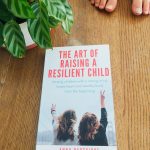By Anna Partridge

Classrooms are hubs for student learning. Traditional classrooms teach children how to read and write and do maths. In the modern classroom, social and emotional development is just as important as academics. Student wellbeing is high on the agenda and a regular focus. Research shows that high EQ (Emotional Intelligence) is a better indicator of success than a high IQ so it is imperative that students learn these skills at school as well as reading and writing.
Since 2016, I have had the pleasure of using my already established research and knowledge of resilience and emotional intelligence in children to design programs, change pedagogy and work with students to continue this work. Below are some of the initiatives we are working on.
Cool Kids Anxiety Program – with 1 in 7 children in Australia experiencing mental health issues, it was important to address the student’s needs and implement this 10 week program founded out of Macquarie University to give kids strategies to deal with anxiety. It is practical, easy to implement and the tool kit works for up to 5 years.
Positive reframing – our default position as humans is to look for the negatives. When we are always looking for the negatives, our thought pattern becomes stuck in what went wrong. To change this perception, our students and staff have the opportunity to reflect on What Went Well for their week on this graffiti wall in classrooms. It has become a talking point among the students and something they look forward to each week. We also focus on gratitude through journals, our Morning Prayer circle and as a staff during our morning meetings.
Classroom rituals, Structure and Routines – the first 20 minutes of the day is dedicated to student personal development. In most classrooms there is a predictable structure to the morning circle that ends with a class motto for example ‘I matter. I belong. I will succeed.’ This predictability allows children to know what they are walking into each morning and start of calmly. Habit forming and structure is important for kids to know what to expect and start well.
Present. Centred. Grounded – Each classroom practices some form of meditation. This could be in the form of using the app, Smiling Minds, a short meditation routine e.g. 3Bs or sitting still with a bell in the morning circle that is generally run by the students. In addition, emotional coaching our students is important using the red/green feelings chart and a dedicated positive psychology program, Bounce Back that runs in Years 1, 3, 4 and 5.
Brain Breaks – research shows that students who have a break in their learning every 15 to 20 minutes are 70 per cent more engaged in their learning! These statistics make it easy to add in fun brain breaks throughout the day. My clever husband and I designed a brain break spinner for my classroom that the kids love to spin to see which one they are doing to do. We add more as we find more – it is fun!
Learning Brain Zone – The mindset of students plays a huge role in their learning. Being able to develop a positive, growth mindset helps with student engagement and overall learning. To do this, we run a dedicated program in Kindy, Year 2, Year 4 and Year 6 to develop this mindset. This is through working on strengths, understanding how the different parts of the brain works to aid learning and making it cool to get into the DIP. We also do this through a tool called the Learning Brain Zone. Self-regulation has been indicated as one of the major strength for success in life – the learning brain zone is a tool each student uses to develop their own engagement and regulation in learning. It allows students to develop their own strategies to reengage in learning and I know it is working when kids start asking for a brain break. The strategies are simple – get a drink, go for a walk down the stairs and back up, read a page of a book, do a brain break. The students choose what works best for them and the output is amazing once they have mastered their own strategy to reengage. It is exciting to see.
Whole school Mental Health and Wellbeing Week – In Term 3, Week 9 we dedicate the week to mental health and wellbeing hosting speakers, doing classroom activities and entertainment. Last year we had Menslink come in to speak to the Years 4, 5 and 6 boys, Brendan Mahar, CEO of R U OK? Speaking to Years 4, 5 and 6, the Playground Craze doing a play on resilience for Preschool to Year 4, a mindfulness and meditation practitioner working with our Year 5s for the day, screen hook ups with Kids Helpline in the classrooms, a visit from the Companion Dogs for Years 2 and 3 and a staff lunch. We engage parents, staff and students in a week of wellbeing. It is a great week at school with lots of engagement and great conversation. Our idea is that if we can plant the seed in just a couple of kids that is it OK to seek help when they are stuck or turn around from a tricky time, we have helped. From feedback with the kids, I know we reach more than a few kids.
Measuring wellbeing – this is the hard part! After a trail last year, this year for the students we are running a Wellbeing in Education survey looking at overall health and wellbeing, sense of belonging, peer relationships, resilience, bullying, anxiety and sadness. It gives us an individual score for every child from Years 4 to 6 and wellbeing over time. Last year, we used it to flag bullying, anxiety and sadness with programs (Bounce Back small group and Cool Kids), referring to the school counsellor, individual and group discussions and parent discussions. We also measured the staff wellbeing in Week 9, Term 3 with some interesting feedback.
Buddies Program – To facilitate conversation for both students AND teachers, we now have a buddies program across the school. Year 6 buddies with Kindy, Year 5 with preschool and Year 4 with Year 1. It is a time of engagement between years, fun between the grades and time for teachers to have a conversation. The staff feedback last year requested increased time to connect and this is one way we facilitate this. Initial feedback has been very positive for students and staff including helping kids to feel safe and secure on the playground.
While we can implement programs and make the pedagogy more relevant, the heart of student wellbeing really comes from the culture of the school and the teachers and staff themselves. When the staff’s wellbeing is high, it is passed onto the children. When the culture is one of care and nurturing, the school hums. The genuine care and community spirit that radiates from our school in every facet allows the students and staff to feel supported. As our school motto suggests, the teachers and staff’s ability to do small things with great love on a daily basis contributes greatly to student wellbeing. Patience, care, love, genuine support and compassion are shown on a daily basis – you just have to walk around in a break to see it in action. We are lucky to be in a school where the culture of caring is strong and the community comes together in such a way to ensure the heart remains.
Supporting student wellbeing is taking hold across schools, sectors and even countries. Ireland and now England have mandated for a program to be in every school to support student wellbeing and Australia is not far behind. Raising confident, resilient, emotionally intelligent students will ideally reduce the incidence of mental health issues and increase positive interactions and individual’s contribution to a healthy society.






